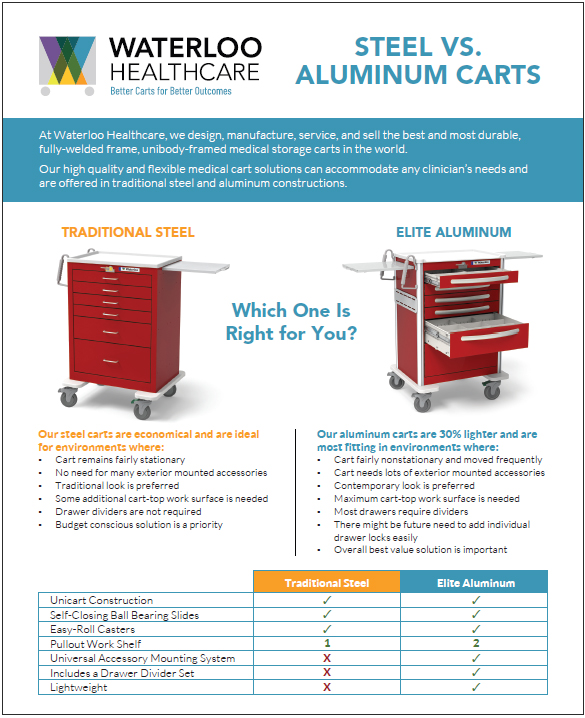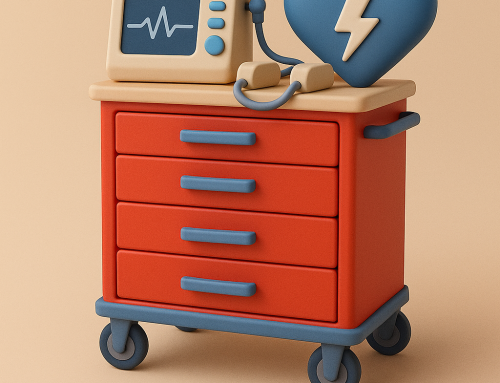When choosing a material for your next Waterloo medical cart, one of the options you’ll encounter is whether you should select steel or aluminum construction. To make the right decision, you’ll need to consider several factors relative to the intended use of your medical cart. Some of these considerations include mobility, any potential future need to add accessories, aesthetics, the need for a larger work surface, and our drawer dividers (which we highly recommend) are just some of the requirements you’ll need to investigate.
Simply put: If budget is the most important factor in your decision, then a steel cart would be your initial starting point. But hold on just a moment because there are some criteria that could make an aluminum cart the right choice, even in the face of a challenging budget. We’ll investigate some of those criteria within this article.
The Waterloo traditional steel procedure cart is the backbone of the Waterloo product line. We have been building steel procedure carts for well over 50 years and you’d be hard–pressed to find a hospital that doesn’t have a Waterloo cart somewhere within its hallways. The reason for this is simple – it’s the perfect balance of durability and economy. It gets the job done and will continue to do so for years and years. We’ve encountered Waterloo steel carts in hospitals that have been in service for decades… no joke!
The Waterloo aluminum cart is the “new kid on the block” (relatively speaking) as it’s been around for over a decade. It takes our traditional steel cart to the next level with features such as included metal drawer dividers, dual pull-out work surfaces, modular accessory mounting, and a more contemporary look; all of this in a lightweight, easy-to-maneuver platform. It’s the best “bang for your buck” when it comes to medical carts!
So what should you choose… steel or aluminum?
Let’s consider your mobility needs. How active will this cart be? Will staff be moving it from room to room or will it largely be stationary? The reduced weight (up to 30% lighter) of our aluminum cart will make it far easier for your team to maneuver. Aluminum is a strong contender for active procedure carts. Conversely, if the cart is largely stationary, then our traditional steel cart would be a fine choice with the added benefit of being easier on your budget.
Now let’s consider the required work surface. Will your staff be depending on the cart top as their primary worksurface? If so, then our aluminum cart offers a second pull-out work surface and is worth consideration. While our steel carts come standard with one pull out work surface, the added advantage of virtually doubling the available workspace of your cart with the second pull-out side shelf makes aluminum your choice when cart top work surface is a primary consideration.
Will you be adding trays and dividers to your procedure cart? If so, then it is important to consider that the Waterloo aluminum cart comes standard with metal drawer dividers in each drawer. Trays and dividers range in price from $50-$300 each depending on style. That means that a six drawer steel cart could require you to purchase between $300-$1800 in trays/dividers per cart! In many cases, the included drawer dividers alone can offset the additional cost of an aluminum cart. Our cart consultants can help you evaluate the cost of steel carts versus aluminum carts when factoring in your need for trays/dividers. Oftentimes, aluminum ends up being the most economical solution due to the significant savings on additional drawer dividers and trays!
Next, let’s consider the potential evolution of your new procedure cart. Do you foresee adding accessories or needing to change its configuration down the road? With a Waterloo aluminum cart, accessory locations can be fine-tuned as they are mounted to accessory panels that can be adjusted in very small increments using nothing but a screwdriver. With steel carts, accessories get mounted in fixed locations via pre-drilled holes. This limits accessory mounting options unless you are willing to drill into a steel cart to create a new mounting location. By the way, our steel cart is designed to be drilled as needed and doing so does not void your 5-year warranty. The Waterloo aluminum cart is by far the most modular and easy-to-reconfigure cart that we manufacture. It allows you to reconfigure your cart without needing to get maintenance involved, which can be a huge time saver.
Finally, let’s look at aesthetic considerations. While we feel our traditional steel cart is a very attractive cart (as far as carts go), our Waterloo aluminum cart “ups the ante” with nicely rounded corners and a very contemporary look! With its broad, brushed metal drawer pulls, rounded corner tracks for mounting accessories, and the lack of pre-drilled holes, our aluminum cart will help elevate its surroundings. It is ideal for patient-facing areas of your facility where you want to convey a modern aesthetic. It complements any décor and can help elevate your patient’s overall experience while at your facility. At the end of the day, it’s a medical cart, but just because it’s designed to be functional doesn’t mean it can’t look good while doing its job. We feel the Waterloo aluminum cart looks as great as it is functional.
Let’s end with an overview of common cart types in a clinical setting and which material makes sense, given the cart’s expected usage.
Emergency Code Carts are highly mobile/active carts that require a good deal of work surface and a high level of organization so that clinicians can treat patents quickly. Consider aluminum for its maneuverability, dual slide-out work surfaces and “out of the box” organization with included metal drawer dividers.
Anesthesia Carts are moderately mobile carts that require additional work surfaces and need to be extremely organized. Aluminum would be the first consideration for the same reasons listed above for code carts. Anesthesia carts can be highly evolutionary relative to other types of procedure carts which means that anesthesiologists can reconfigure the cart by adding and moving accessories over time. This plays right into the strength of the aluminum cart’s modular accessory panels. With just a screwdriver, you can reconfigure the cart at a moment’s notice.
Bedside Carts largely sit idle in a patient room, making steel a great option for bedside carts. Since these types of carts are usually purchased in large quantities, the lower cost of our steel option helps with your budget. That said, the aesthetic appeal of our aluminum cart should be considered as this cart is patient-facing and may help (in some small way) with your patient satisfaction scores.
Isolation Carts are moderately mobile carts that are deployed throughout the hospital. Depending on how often your facility deploys isolation carts, both steel and aluminum can work in this application. The built-in drawer dividers offer just enough organization to eliminate the need to purchase additional trays, while the lighter weight will help staff when they are moving the carts throughout your facility. That said, steel is also a fine choice as the carts are largely stationary outside a patient room once deployed.
With both steel and aluminum carts to choose from, Waterloo Healthcare offers a solution to match any need and budget. Our cart consultants are well trained to help you match the right cart for your task. Give us a call today and let us help you improve your patient outcomes!







